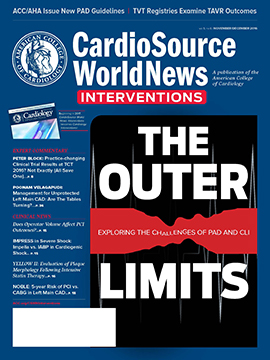NCDR Update | Pair of TVT Registry Studies Examine TAVR Outcomes
CardioSource WorldNews Interventions | At the Transcatheter Cardiovascular Therapeutics (TCT) meeting held this fall in Washington, DC, two studies using data from the Society of Thoracic Surgeons (STS)/ACC TVT Registry examined outcomes related to transcatheter aortic valve replacement (TAVR).
In the first abstract, Matthew Sherwood, MD, FACC, and colleagues studied vascular complications in patient who had undergone TAVR. Between 2011 and 2015, they evaluated 15,704 patients at 359 hospitals in the participating in the TVT Registry. Vascular complications were experienced by 1,771 patients (11%) and bleeding was experienced in 1,442 patients (9%). However, the rates of vascular complications and bleeding both decreased over time. Patient with vascular complications or bleeding events were of similar age and were more often female, had hypertension, peripheral artery disease, cardiogenic shock within 24 hours, or a procedural sheath size > 20Fr compared with those who did not develop these complications. Vascular complications were associated with in-hospital death, and death or rehospitalization at 1 year. Bleeding events were also associated with in-hospital death, and with death, rehospitalization or stroke at 1 year.
Sherwood and colleagues concluded that while vascular complications and bleeding have decreased over time, both are associated with short- and long-term adverse events. These findings show that there is a need for safer approaches to TAVR.
In the second study, Paul Sorajja, MD, FACC, and colleagues compared the outcomes of TAVR with the new repositionable Evolut R platform to those observed with the CoreValve platform. Patients in the TVT Registry undergoing TAVR for native aortic stenosis using a 23, 26, or 29 mm Medtronic self-expanding prosthesis (CoreValve TAV or Evolut R TAV) were included in this analysis.
Compared to patients treated with CoreValve, those who receive Evolut R were similar in age (81.3 ± 8.1 years vs. 81.6 ± 8.1 years; p = 0.12), had lower STS-PROM (8.0 ± 5.3% vs. 8.7 ± 5.3%; p < 0.001) and a greater use of transfemoral access (91.8% vs. 89.0%; p = 0.02). With Evolut R, there was a lower acute need for a second prosthesis [2.6% vs. 4.6%; p < 0.001], less device migration (0.2% vs. 0.6%; p = 0.01), a lower incidence of moderate or severe paravalvular regurgitation (4.3% vs. 6.4%; p = 0.002), and shorter length of hospital stay (median, 4.0 vs. 5.0 days; p < 0.0001). Overall, patients treated with Evolut R had a greater frequency of acute procedural success (96.2% vs. 94.7%; p = 0.007). At 30-day follow-up, major vascular complications and residual aortic gradients after TAVR were low in both groups [8.7 mmHg vs. 7.9 mmHg; p < 0.001], while all-cause mortality and the need for permanent pacemaker was lower for those who received Evolut R.
The authors concluded that the use of Evolut R for TAVR is associated with significant clinical improvements acute procedural outcomes for patients undergoing TAVR for aortic stenosis.
References
- Sherwood M, Xiang Q, Matsouaka R, et al. J Am Coll Cardiol. 2016;68(18_S):B32.
- Sorajja P, Kodali S, Reardon M, et al. J Am Coll Cardiol. 2016;68(18_S):B271-B272.

|
Read the full November/December issue of CardioSource WorldNews Interventions at ACC.org/CSWNI |
Keywords: CardioSource WorldNews Interventions, National Cardiovascular Data Registries, Transcatheter Aortic Valve Replacement, Hypertension, Peripheral Arterial Disease, Registries, Shock, Cardiogenic, Stroke, Surgeons
< Back to Listings
